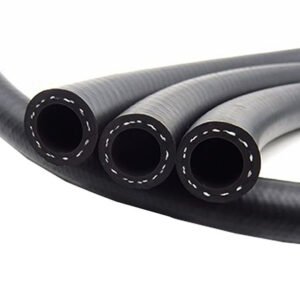Rubber hoses for sale play important roles in heating, ventilation, and air conditioning (HVAC) systems, contributing to the efficiency and functionality of these systems.
Here’s how rubber hoses are utilized in HVAC applications:
- Air Duct Connections: Rubber hoses are used to connect various components within HVAC air duct systems. They facilitate the transfer of air between the main HVAC unit and individual ducts, ensuring a sealed and efficient pathway for conditioned air.
- Ventilation Systems: In ventilation systems, rubber hoses help transport fresh air from the outside to the HVAC unit. They may also be used to exhaust stale air or fumes from indoor spaces, contributing to a healthy indoor air quality.
- Exhaust Systems: Rubber hoses are employed in exhaust systems of HVAC units to expel air or gases generated during the heating or cooling process. These hoses are designed to withstand the temperature and pressure conditions associated with exhaust applications.
- Flexible Ducting: Rubber hoses are used as flexible ducting in HVAC systems, allowing for the efficient routing of air in spaces where rigid ducts may be impractical. The flexibility of rubber hoses facilitates installation in challenging or confined areas.
- Cooling Systems: Rubber hoses may be used in cooling systems within HVAC units to transfer coolant or refrigerant. These hoses contribute to the heat exchange process, helping to regulate the temperature of the air circulated in the space.
- Heating Systems: In heating systems, rubber hoses can be part of the fluid transfer systems, assisting in the circulation of heated water or other heat transfer fluids. They play a role in transferring heat from the heat source to the air handling units.
- Humidification Systems: Rubber hoses may be utilized in humidification systems within HVAC units to transport water or steam for the purpose of adding moisture to the air. These hoses contribute to maintaining optimal humidity levels in indoor spaces.
- Condensate Drainage: Rubber hoses are used in condensate drainage systems to transport water generated during the cooling process away from HVAC units. These hoses help prevent water buildup and potential damage to the system.
- Vibration Dampening: Rubber hoses contribute to the dampening of vibrations within HVAC systems. They absorb and reduce vibrations generated by fans, compressors, and other moving parts, improving the overall stability and quiet operation of the system.
- Customized Applications: Rubber hoses for sale in the HVAC sector can be customized to meet specific requirements, such as size, length, and material composition. This customization ensures that the hoses are tailored to the unique needs of different HVAC applications.
In summary, rubber hoses in HVAC systems contribute to air circulation, temperature regulation, and overall system efficiency. Their flexibility, durability, and compatibility with varying temperatures make them valuable components in the diverse applications of heating, ventilation, and air conditioning systems.
What roles do rubber hoses play in industrial settings for the transfer of various fluids?
Rubber hoses play crucial roles in industrial settings for the transfer of various fluids. These hoses are designed to withstand the challenges of transporting different types of liquids and gases within industrial processes.
Here are some key roles that rubber hoses fulfill in industrial fluid transfer applications:
- Chemical Transfer: Rubber hoses are used to transfer a wide range of chemicals within industrial facilities. They are designed to resist the corrosive effects of different chemicals, ensuring safe and efficient transfer without degradation.
- Oil and Fuel Transfer: In industrial machinery and equipment, rubber hoses are employed for the transfer of oils and fuels. rubber hose for sale These hoses are resistant to the specific properties of various oils and fuels, providing reliable and leak-free transportation.
- Water and Steam Handling: Rubber hoses are utilized for the transfer of water and steam in industrial processes. They are designed to handle different temperature ranges and pressures associated with water and steam applications, including cleaning, heating, and cooling.
- Air and Gas Transfer: Industrial processes often require the transfer of compressed air and various gases. Rubber hoses are suitable for these applications, providing a flexible and durable means of conveying air or gases within a facility.
- Abrasive Material Handling: In industries dealing with abrasive materials such as sand, gravel, or powder, rubber hoses are employed for material transfer. They are designed to resist abrasion and wear, ensuring longevity in applications like pneumatic conveying.
- Hydraulic Systems: Rubber hoses play a critical role in hydraulic systems, transferring hydraulic fluids to power machinery and equipment. These hoses are designed to handle high pressures, providing a flexible and reliable connection in hydraulic applications.
- Food and Beverage Processing: Rubber hoses suitable for food and beverage processing are used to transfer liquids and fluids in compliance with food safety regulations. These hoses ensure the hygiene and integrity of food and beverage products during processing.
- Coolant Systems: In industrial machinery and manufacturing processes, rubber hoses are employed to transfer coolant fluids. These hoses play a key role in maintaining optimal operating temperatures in machinery, preventing overheating and ensuring efficient operation.
- Waste Handling: Rubber hoses are used in industrial settings to transfer various types of waste materials, including liquids and sludge. They are designed to handle the often harsh and corrosive nature of industrial waste.
- Pneumatic Systems: Rubber hoses are essential components in pneumatic systems, transferring compressed air to power pneumatic tools and machinery. These hoses provide flexibility and durability in pneumatic applications.
In summary, rubber hoses are versatile components in industrial fluid transfer applications, addressing the diverse needs of different industries. Their resilience to a variety of fluids, resistance to abrasion and corrosion, and flexibility make them indispensable for ensuring the smooth and reliable transfer of fluids within industrial processes.
